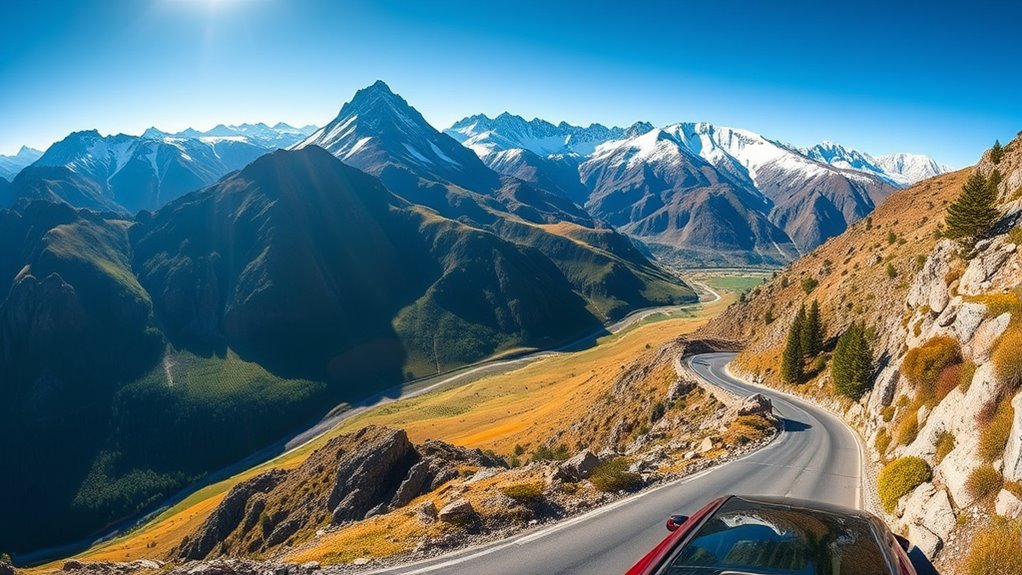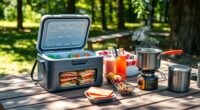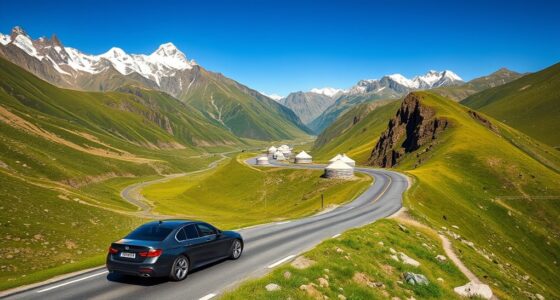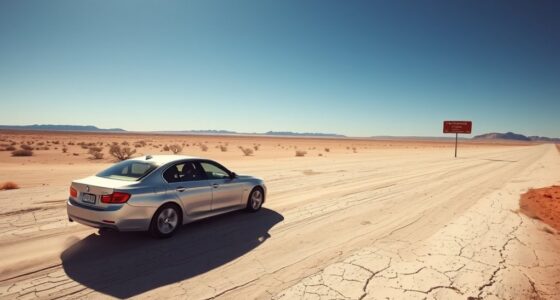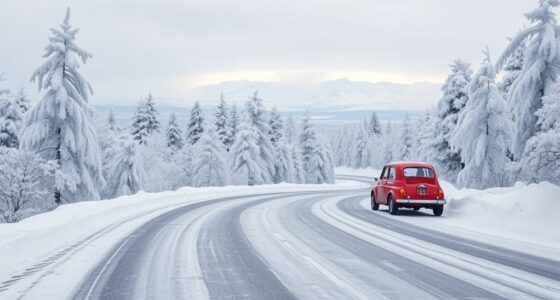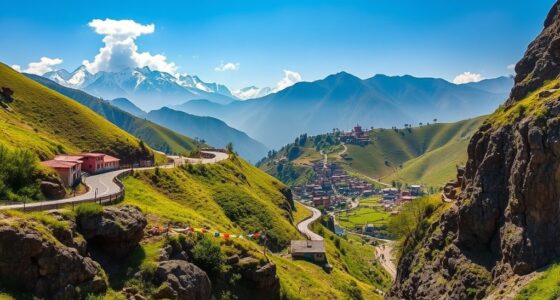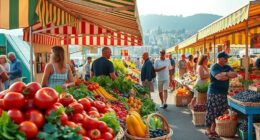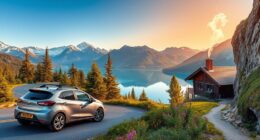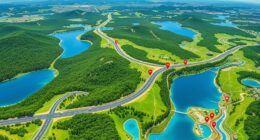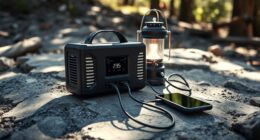Driving the Andes from Mendoza to Santiago offers stunning mountain views, high-altitude passes, and vibrant local culture. Make certain your documents, like passports and vehicle papers, are in order for the border crossing. The best time to go is spring or early summer to avoid snow and ice. Be prepared for weather changes, altitude sickness, and rough roads. Planning ahead ensures a safe trip—keep exploring for detailed tips and must-see stops along this remarkable route.
Key Takeaways
- Ensure your vehicle is well-maintained and equipped for high-altitude driving, including checking tires, brakes, and fluids.
- Carry all necessary documents: passports, vehicle registration, insurance, and border crossing paperwork.
- Start your journey during spring or early summer (October-December) for better weather and road conditions.
- Be prepared for mountain passes like Paso Los Libertadores with winding roads, snow, and potential rockfalls.
- Plan for border crossing procedures, customs checks, and have patience for variable lines and officials’ questions.
Planning Your Route and Necessary Documents
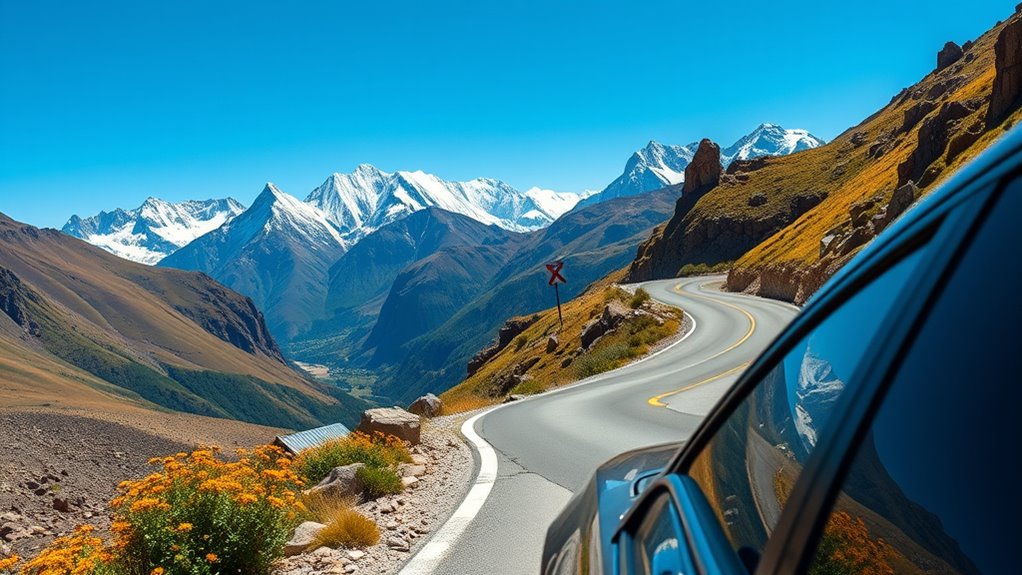
Before setting out on the drive from Mendoza to Santiago, you should carefully plan your route and make certain you have all the necessary documents. Make certain your vehicle registration is up to date, as border crossings require proof of ownership and compliance with local regulations. Carry both original and copies of your passport, driver’s license, and any visas needed for Chile. It’s also essential to have valid travel insurance that covers emergencies, accidents, and medical expenses abroad. Having these documents organized will help you avoid delays at customs and border control. Double-check your vehicle’s insurance details and ensure they meet Chilean requirements. Preparing everything in advance guarantees a smoother journey, letting you focus on enjoying the spectacular scenery rather than worrying about paperwork. Being aware of passport and visa requirements can prevent potential issues during border crossings. Additionally, understanding border crossing procedures can facilitate a more efficient transit. Familiarizing yourself with local regulations can also help you comply with the rules and avoid penalties during your journey. To further ensure a seamless trip, researching customs regulations specific to Chile can help you avoid unexpected delays. Moreover, reviewing insurance policies that meet Chilean standards can prevent complications in case of emergencies.
Best Time to Embark on the Journey
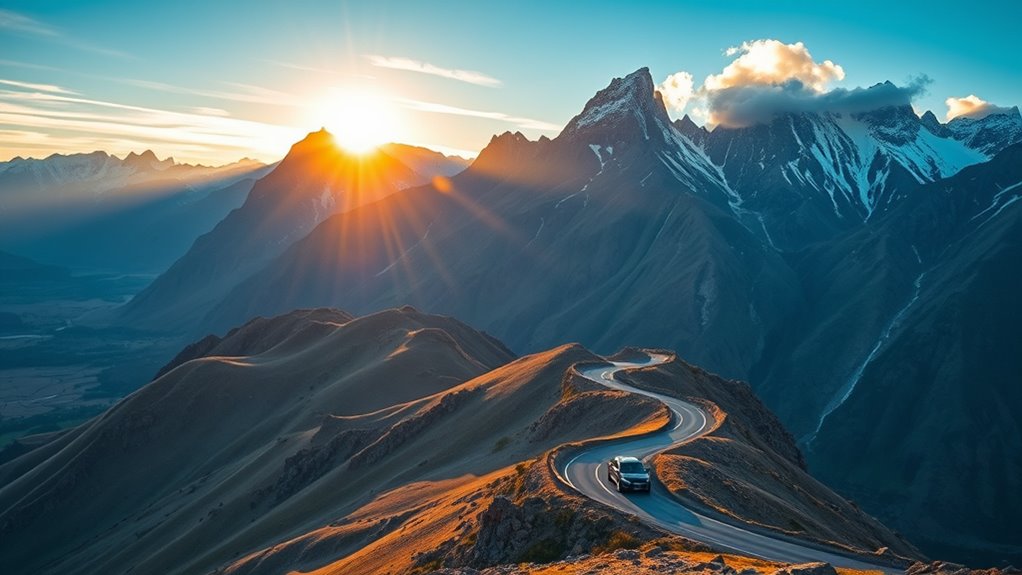
Choosing the best time to commence the drive from Mendoza to Santiago ensures a safer and more enjoyable journey. Typically, the ideal period is during the Southern Hemisphere’s spring and early summer, from October to December, when the weather is mild and the roads are clear. Avoid traveling in winter (June to August) when snow and ice can complicate crossing the Andes, and the weather is often harsh. The peak tourist seasons, especially around holidays, can mean crowded border crossings and higher prices. Planning your trip during shoulder seasons offers better weather and fewer crowds. Consider these factors:
- Best weather for driving and sightseeing
- Lower crowds during shoulder seasons
- Less likelihood of snow or ice on the roads
- Avoiding peak tourist seasons for a smoother trip
- Being aware of weather-related challenges can help you prepare for unpredictable conditions. Additionally, understanding the seasonal climate variations can further aid in planning your journey. Being informed about road conditions during different times of the year can also contribute to a safer trip.
Key Stops and Sightseeing Opportunities
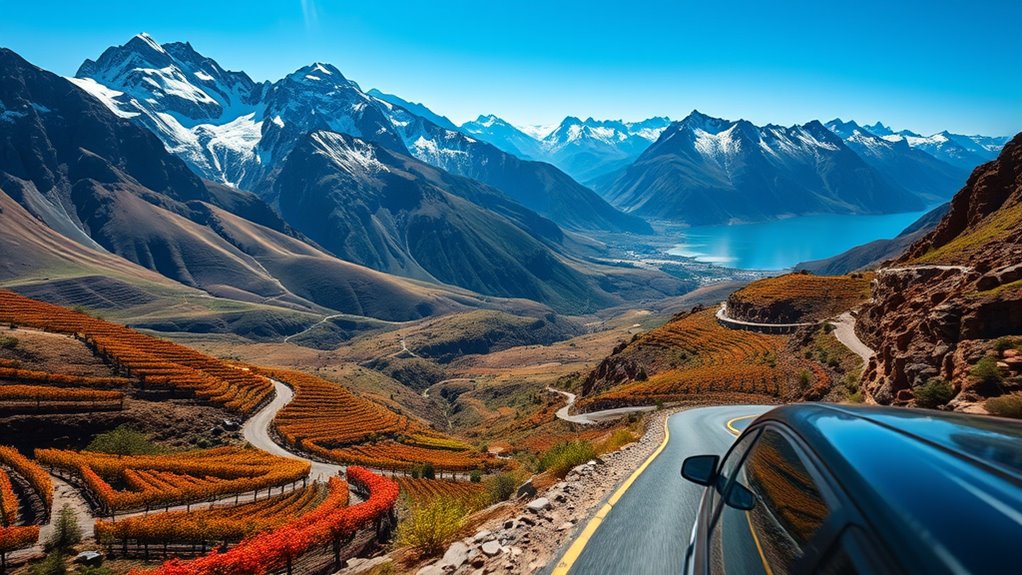
As you drive from Mendoza to Santiago, you’ll encounter a variety of mesmerizing stops that showcase the region’s natural beauty and cultural richness. One highlight is the breathtaking Andes views that surround you at every turn, especially from the mountain passes. These passes, such as the Paso Los Libertadores, offer dramatic scenery and a sense of adventure. Stop at scenic viewpoints along the way to take in panoramic vistas of snow-capped peaks and rugged landscapes. You might also explore small towns that reflect local traditions and history. Each stop provides a unique glimpse into the region’s heritage, making your journey not just about reaching Santiago but also about immersing yourself in the stunning natural environment of the Andes. Be mindful of the cost considerations involved in traveling through remote mountain areas, including expenses for permits, fuel, and accommodations. Additionally, it’s important to stay updated on safety and infrastructure conditions, as weather and maintenance can impact travel plans in these high-altitude regions. Planning ahead can help you navigate driving challenges and ensure a safe and enjoyable trip. Remember that altitude effects can influence travelers, so taking breaks and staying hydrated can enhance your experience. Moreover, understanding cookie categories can improve your online browsing experience when researching travel information.
Navigating the International Border Crossing
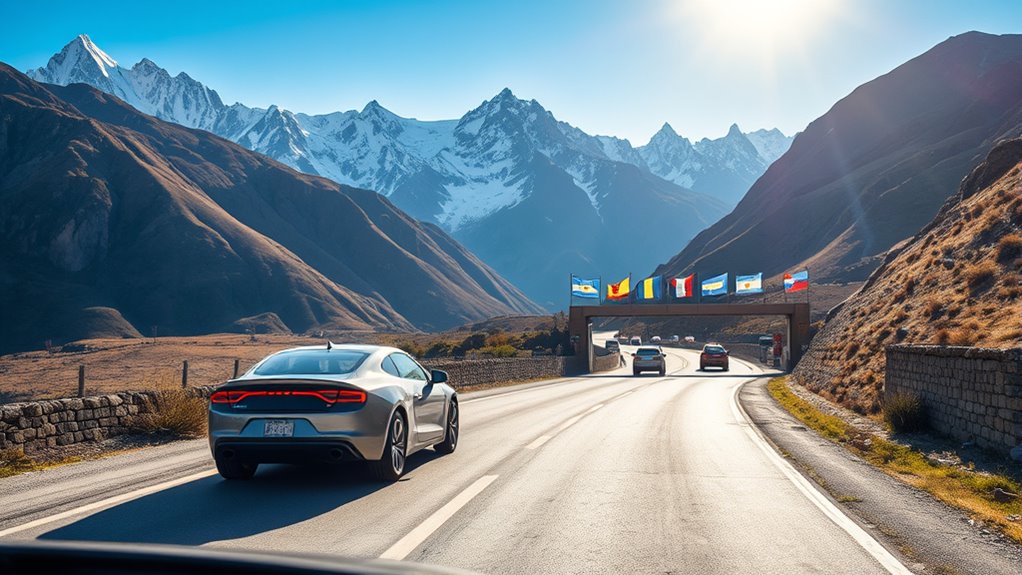
Driving through the Andes from Mendoza to Santiago means crossing an international border, and knowing what to expect can make the process smoother. When approaching the border crossing, be prepared for customs procedures that may require showing your passport, vehicle documents, and declarations for any goods. Keep your paperwork handy and follow signs closely to avoid delays. Be patient, as lines can vary depending on the time and season. To speed up the process, have your documents organized and ready for inspection. Remember, border officials may ask questions about your trip or belongings. It’s helpful to remain calm and cooperative. Being aware of border procedures such as customs checks and document verification can further ease your crossing experience. Additionally, understanding privacy policies and the use of security measures at the border can help you better navigate the process. Familiarizing yourself with border security measures, which often include surveillance and biometric checks, can also streamline your experience. Moreover, having some knowledge of home decor elements can help you feel more comfortable and relaxed during your wait. Being informed about health and safety protocols, such as COVID-19 guidelines, can also contribute to a smoother crossing.
Driving Tips for High-Altitude Passes
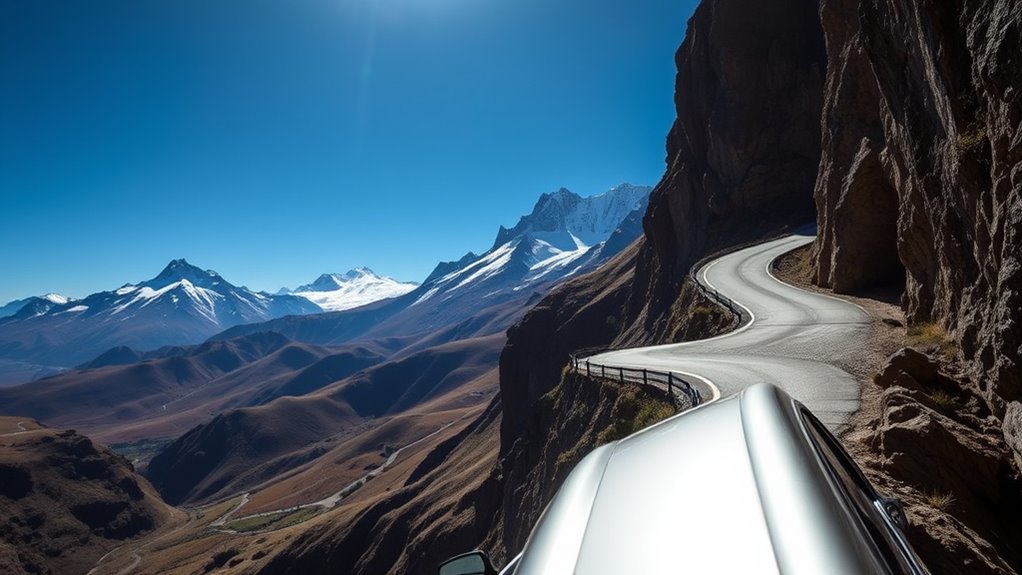
When traveling through high-altitude passes, it is crucial to adjust your driving to accommodate thinner air and changing road conditions. Altitude adaptation is key; take breaks if you feel dizzy or fatigued, and stay hydrated. Keep your speed moderate, as sudden acceleration can strain your engine and tires. Be especially attentive to road condition awareness—mountain passes often have narrow, winding roads with loose gravel or snow. Slow down on sharp curves and watch for falling rocks or ice patches. Use low gears when descending steep inclines to maintain control and prevent brake overheating. Staying alert and adapting your driving style ensures safety amid unpredictable conditions, helping you navigate these majestic but challenging high-altitude routes confidently. Incorporating proper vehicle maintenance and checking tire pressure can also improve safety and performance in these environments before your trip. Additionally, familiarizing yourself with security systems can help you safeguard your vehicle and belongings during stops or overnight stays. Remember that fuel efficiency may vary at high altitudes, so plan your stops accordingly to avoid running out of fuel in remote areas.
Essential Safety Precautions and Vehicle Preparation
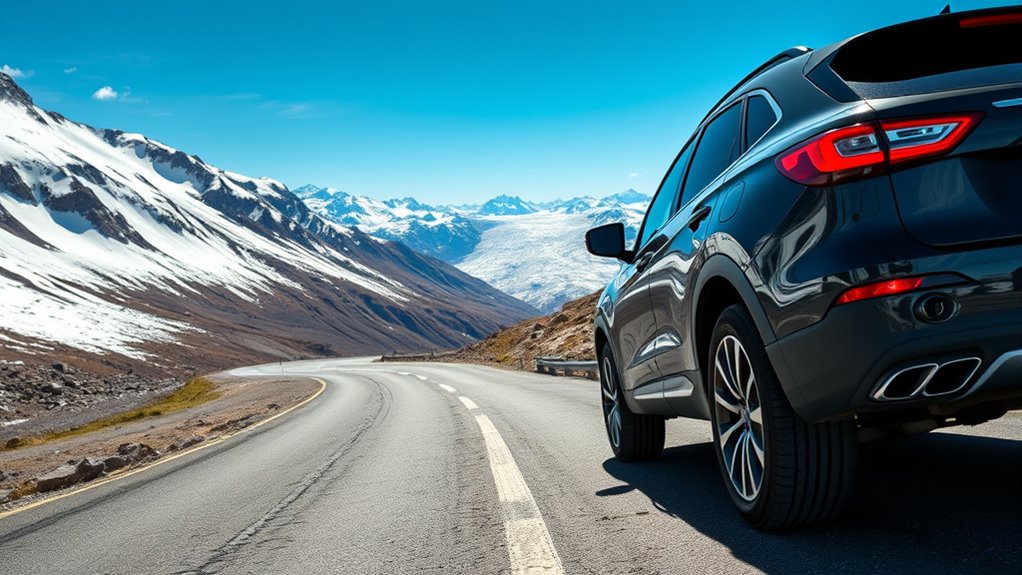
Before hitting high-altitude passes, it’s vital to make certain your vehicle is ready for the demanding conditions ahead. Proper vehicle maintenance ensures your car can handle the steep climbs and thin air. Check tire pressure and tread, fluid levels, brakes, and engine performance. Carry essential emergency preparedness supplies such as a roadside kit, extra water, warm clothing, and a flashlight. Plan for possible breakdowns by informing someone of your route and estimated arrival time. Keep your phone charged and have a backup power source. Regular maintenance reduces the risk of mechanical failure, while emergency gear offers peace of mind in remote areas. Frictional unemployment can present new opportunities for growth, so being adaptable and prepared is key. Preparing thoroughly helps you stay safe and confident as you traverse the challenging Andean terrain.
Local Cuisine and Cultural Highlights Along the Way
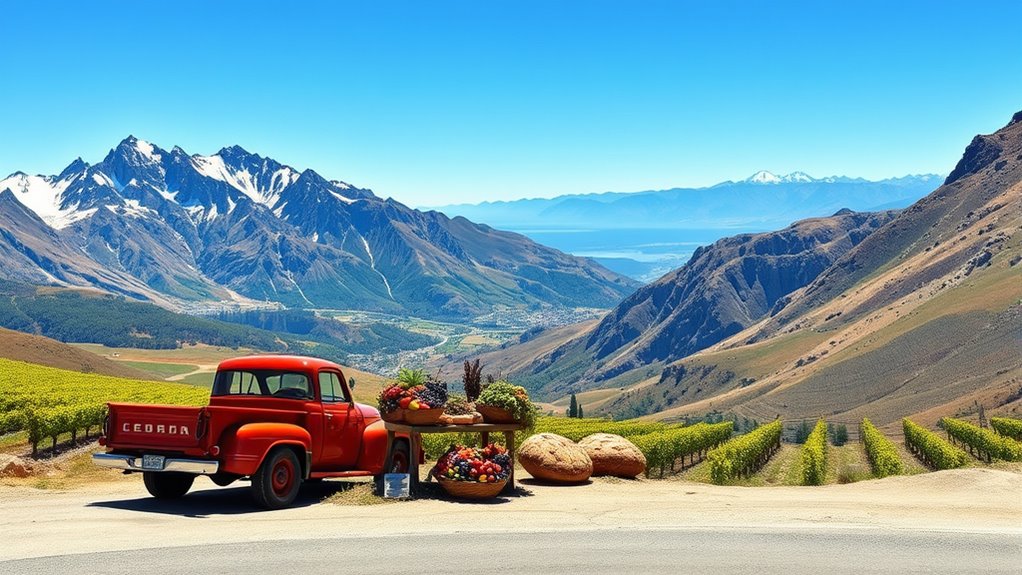
As you journey from Mendoza to Santiago, you’ll encounter a rich tapestry of local flavors and cultural traditions that enrich the scenic drive. Sampling local delicacies like empanadas, asado, and quince jams highlights the region’s culinary heritage. Along the way, you might experience vibrant cultural festivals, showcasing music, dance, and crafts that reflect local identity. These events offer a glimpse into the traditions that shape the area’s culture. To emphasize this, here’s a quick overview:
| Cultural Aspect | Local Delicacies | Festivals |
|---|---|---|
| Traditional Music | Empanadas | Fiesta de la Vendimia |
| Art & Craft | Choripán | Grape Harvest Festivals |
| Regional Dances | Asado | Local Parades |
| Cultural Heritage | Quince Jam | Cultural Exhibitions |
Enjoy the flavors and festivities that make this route truly memorable.
Managing Altitude Sickness and Weather Variations
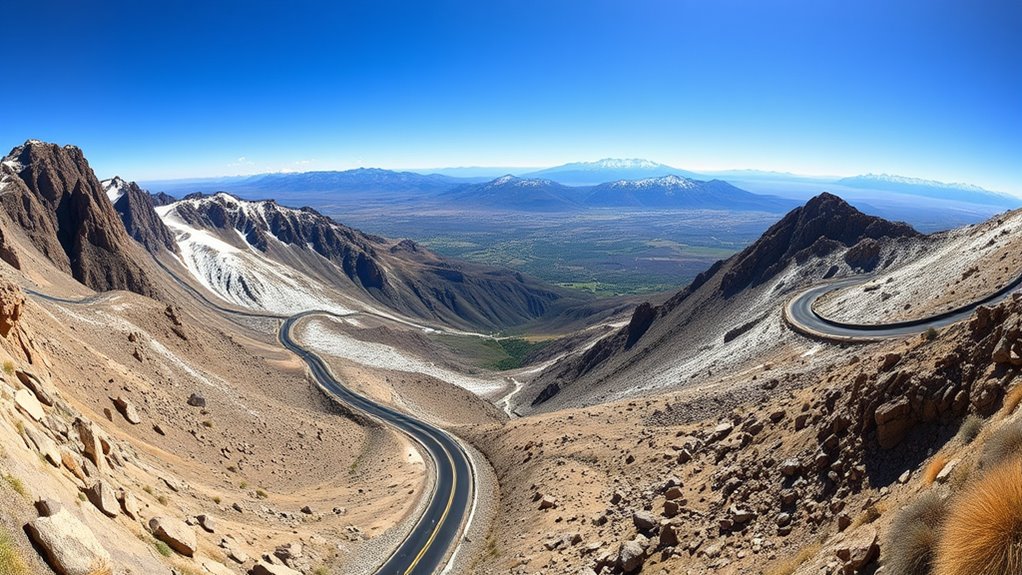
Traveling the high-altitude regions between Mendoza and Santiago requires you to be mindful of altitude sickness and weather changes. To guarantee a smooth journey, focus on altitude adaptation by staying hydrated, avoiding heavy meals, and taking it slow as you ascend. Weather preparedness is equally essential, as temperatures can fluctuate sharply. Prepare for sudden weather shifts by packing layered clothing and checking forecasts regularly. Be alert for symptoms like headaches or dizziness, and descend if symptoms worsen. Here are some tips to manage these challenges:
Be mindful of altitude sickness and weather changes; stay hydrated, dress in layers, and monitor symptoms for a safer journey.
- Stay well-hydrated and avoid alcohol
- Take breaks to acclimate gradually
- Dress in layers for temperature changes
- Keep an eye on weather updates and plan accordingly
Returning and Extending Your Adventure in the Region

After reaching Santiago, consider exploring nearby wine regions like Colchagua Valley or Casablanca Valley to sample world-class wines. You can also immerse yourself in local culture by visiting museums, markets, and historic sites. Extending your trip allows you to enjoy more authentic experiences in this vibrant region.
Exploring Nearby Wine Regions
Once you’ve explored the renowned wine regions around Mendoza and Santiago, extending your journey to nearby areas offers a wealth of new flavors and experiences. You can visit lesser-known vineyards that provide intimate wine tasting sessions and personalized vineyard tours. These regions often feature unique terroirs, producing distinctive wines you won’t find elsewhere.
Some highlights include:
- Small boutique wineries with exclusive tastings
- Organic and biodynamic vineyard visits
- Guided tours through historic wineries
- Tasting local varietals not available in larger regions
Exploring these areas allows you to deepen your appreciation for the local wine culture, uncover hidden gems, and enjoy authentic, immersive experiences that go beyond the usual tourist spots.
Additional Cultural Experiences
As you continue your journey through the region, immersing yourself in its rich cultural tapestry can elevate your experience beyond wine tasting. Attend lively local festivals that showcase vibrant music, dance, and culinary traditions, giving you a genuine glimpse into regional celebrations. Explore traditional crafts, such as handwoven textiles and pottery, often created by local artisans using age-old techniques. Visiting markets and workshops allows you to observe these skills firsthand and even try your hand at crafting. Engaging with the community through these cultural experiences deepens your understanding of local customs and history. These authentic interactions leave a lasting impression, making your trip more meaningful and memorable as you extend your adventure into the heart of the region’s cultural heritage.
Frequently Asked Questions
Are There Any Recommended Travel Apps for the Route?
For route planning and enhancing your travel safety, you should consider apps like Google Maps or Waze. They offer real-time traffic updates and directions, helping you stay on the best route. Additionally, apps like TripIt can organize your itinerary. Using these tools guarantees smooth navigation through the Andes, avoids delays, and keeps you informed about road conditions, making your journey safer and more enjoyable.
What Accommodations Are Available Along the Route?
You’ll find a variety of accommodations along the route, from cozy hostels to luxury hotels. As you cross border crossings, look out for scenic viewpoints where you can stop and enjoy stunning mountain vistas. Many lodgings are near these viewpoints, making it easy to unwind while soaking in the breathtaking scenery. Planning ahead guarantees you find a comfortable spot to rest, whether you’re seeking adventure or relaxation on your journey.
Can I Rent a Vehicle in Mendoza or Santiago?
You can rent a vehicle in both Mendoza and Santiago, offering flexible travel options. Rental options include cars and SUVs, perfect for crossing the Andes. Make sure you meet the vehicle requirements, such as a valid driver’s license and minimum age. It’s wise to compare rental companies and book in advance to secure the best rates and vehicle availability, ensuring a smooth journey through this scenic route.
Are There Any Local Festivals During the Journey Period?
Imagine immersing yourself in vibrant local festivals and cultural celebrations along your journey. During your drive from Mendoza to Santiago, you might encounter lively events like Chile’s Fiesta de la Pampilla or Argentina’s Grape Harvest Festival. These festivals offer a unique glimpse into local traditions, music, and food, making your trip more memorable. Keep an eye on local calendars, as festival dates vary, and you could experience authentic regional festivities firsthand.
What Emergency Services Are Accessible Along the Route?
Along the route, you’ll find emergency roadside services and medical facilities in key towns and along major highways. If you experience car trouble, roadside assistance is available through local providers, and hospitals or clinics are nearby in larger towns like Uspallata or Los Andes. It’s wise to carry a basic first aid kit and keep emergency numbers handy, ensuring you’re prepared for any unexpected situations during your journey.
Conclusion
So, you’ve conquered the Andes, dodged border queues, and marveled at breathtaking vistas—what’s next? Maybe a medal? Or at least a well-earned nap before bragging about your epic road trip. Just remember, the mountains might be majestic, but they’re also experts at turning your GPS into a game of hide-and-seek. Now go ahead, tell everyone you drove through South America’s crown jewels—just don’t forget your sense of humor (and maybe some altitude sickness pills).
